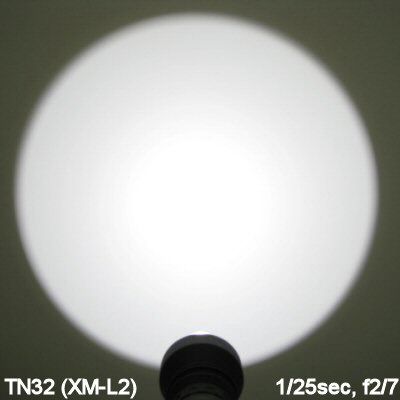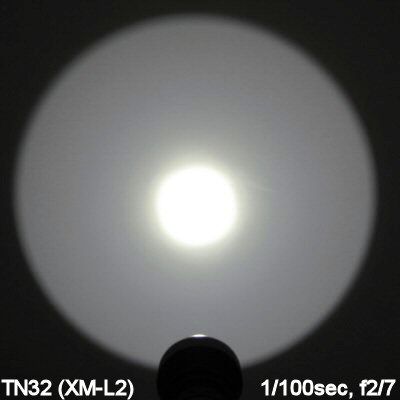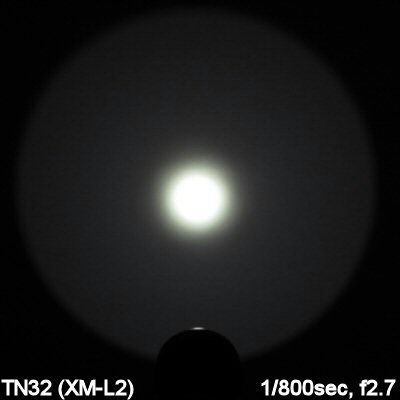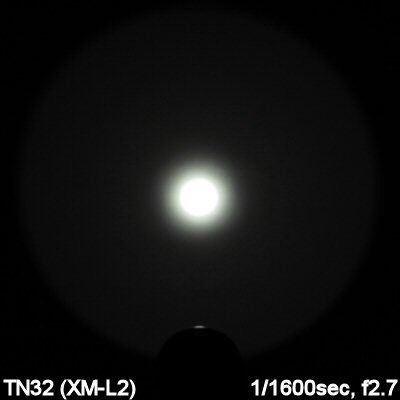Warning: even more pic heavy than usual. 
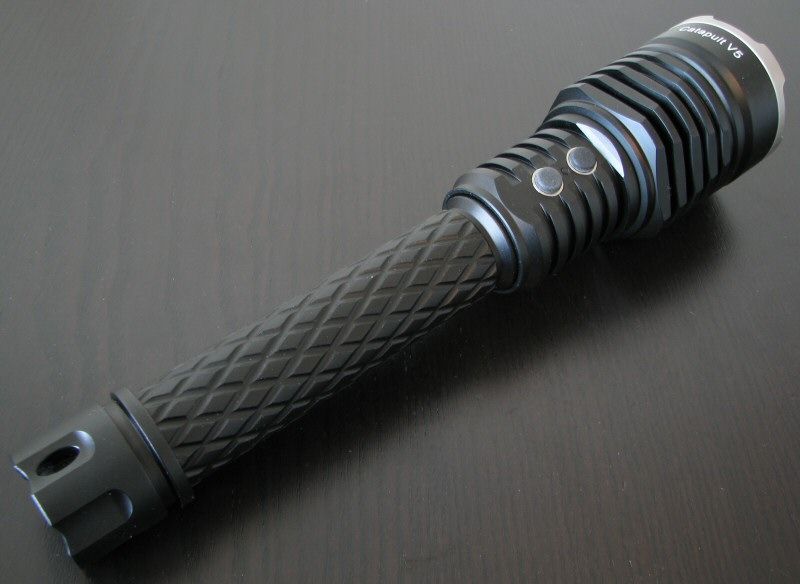
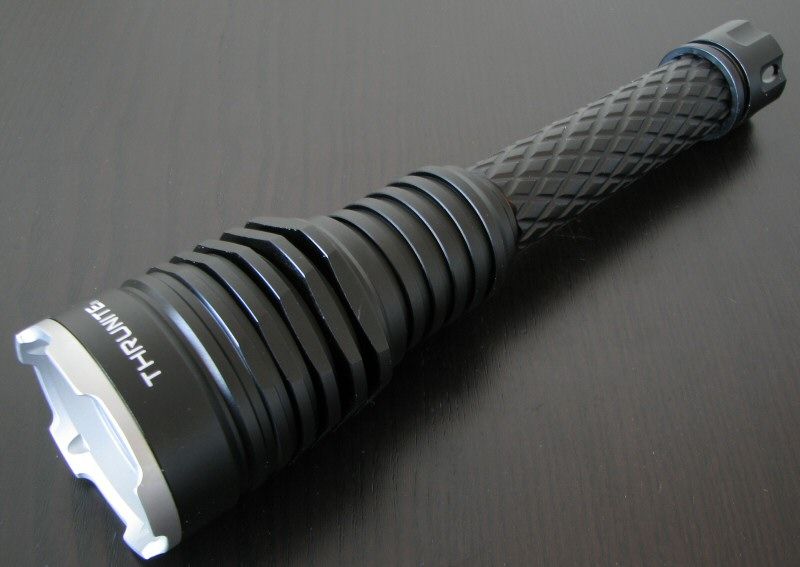
Thrunite has sent me the updated version their classic "thrower" light, the Catapult (now in version 5). Featuring a XM-L2, the Cat V5 runs on 2x18650 or 4xCR123A (although I understand 3x18650 is also possible with optional extender).
Does the V5 version allow Thrunite to reclaim the "throw king" crown in this class? Let us see …
Manufacturer Reported Specifications:
(note: as always, these are simply what the manufacturer provides – scroll down to see my actual testing results).
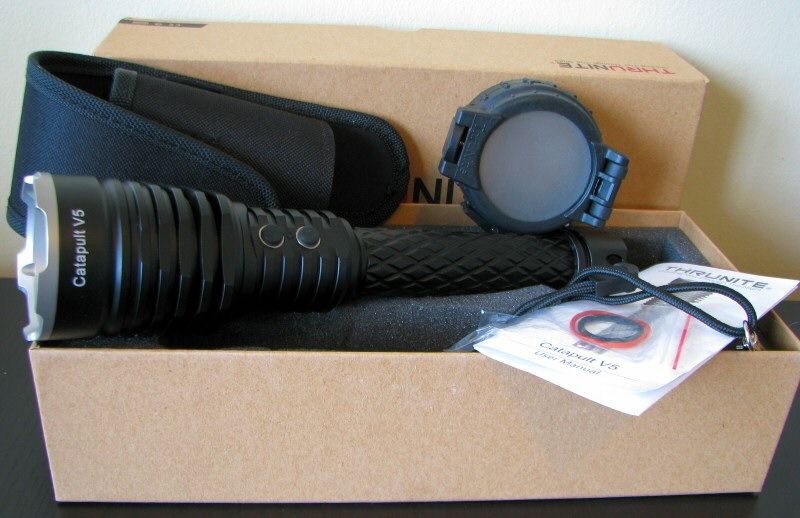
Packaging is a hard cardboard box with cut-out foam. Inside are the light (in bubble wrap), open-ended belt pouch, wrist lanyard, manual, extra o-rings, and snap-on flip-top diffuser cover.
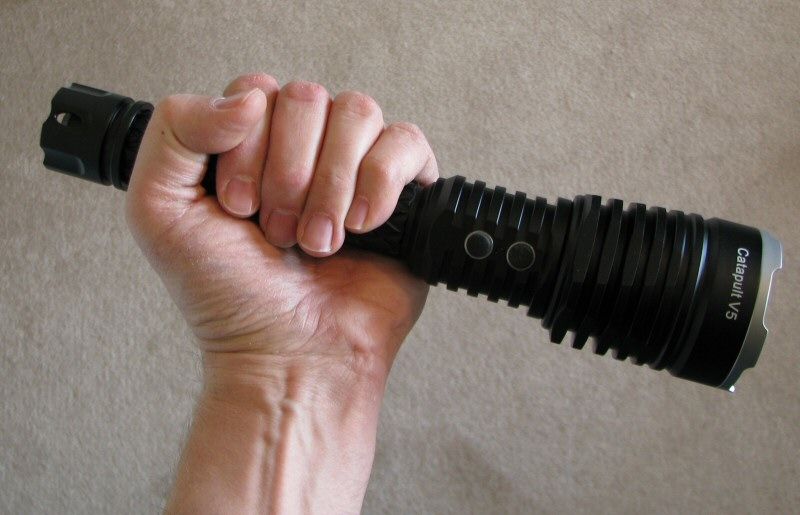

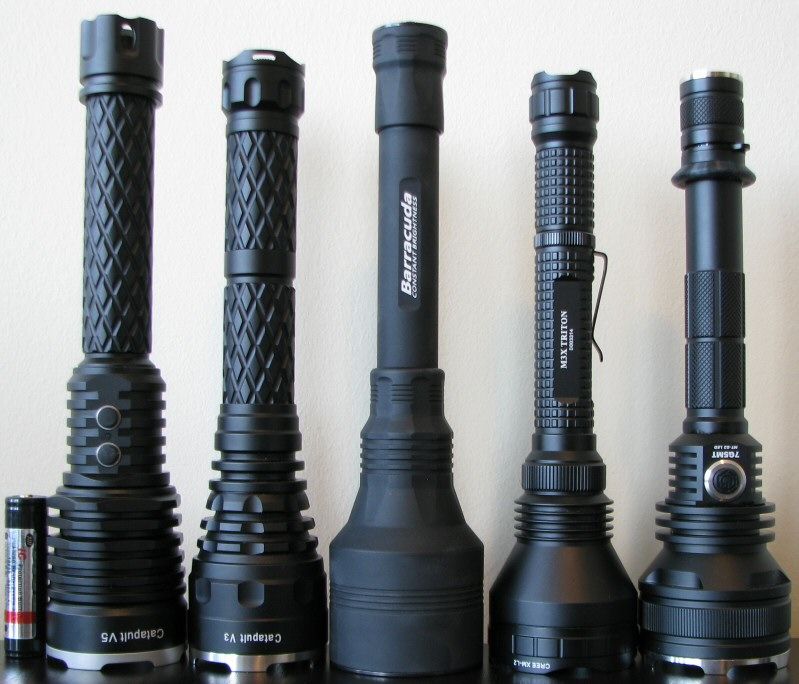
From left to right: AW Protected 18650 2200mAh; Thrunite Catapult V5, V3; Armytek Barracuda; Olight M3X; Crelant 7G5MT.
All dimensions directly measured, and given with no batteries installed (unless indicated):
Thrunite Catapult V5: Weight: 556.7g, Length: 266mm, Width (bezel) 59.1mm
Thrunite Catapult V3: Weight: 434.8g, Length: 254mm, Width (bezel) 58.0mm
ArmyTek Barracuda: Weight 400.8g, Length 264mm, Width (bezel): 64.0mm
Crelant 7G5CS: Weight: 334.5g, Length: 247mm Width (bezel): 64.0mm
Eagletac GX25L2 Turbo: Weight: 320.7g (with battery pack: 412.5g), Length: 251mm, Width (bezel): 62.0mm
Eagletac SX25L2 Turbo: Weight: 343.4g (with battery pack: 534.3g), Length: 255mm, Width (bezel): 62.0mm
Klarus XT30: Weight: 283.1g, Length: 247mm, Width (bezel): 58.0mm
Niwalker 750N1: Weight: 408.0g, Length: 269mm, Width (bezel): 58.6mm
Olight M3X with Extender: Weight 277.8g, Length 244mm, Width (bezel): 62.3mm
Sunwayman T40CS: Weight: 296.7g, Length 227, Width (bezel): 63.5mm
Surefire UB3T: Weight: 311.1g, Length 229mm, Width (bezel): 63.1 mm
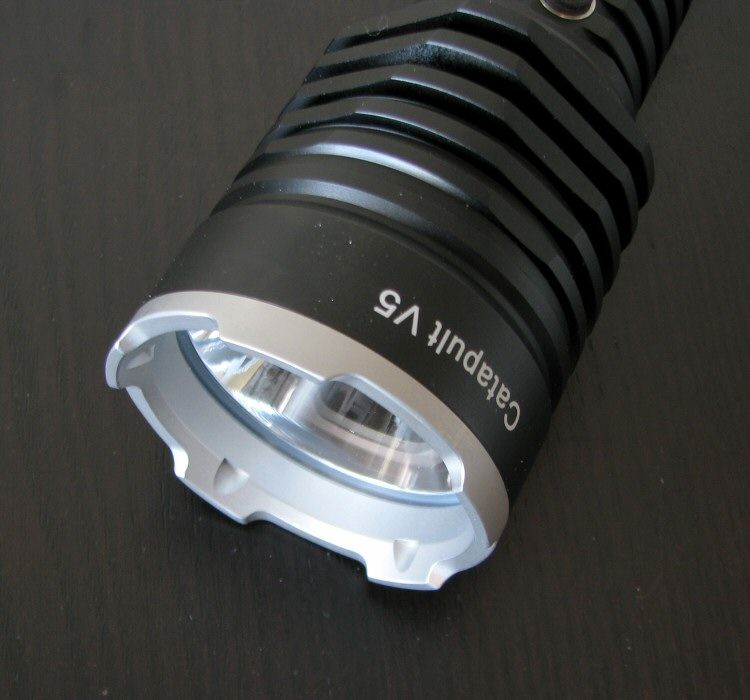

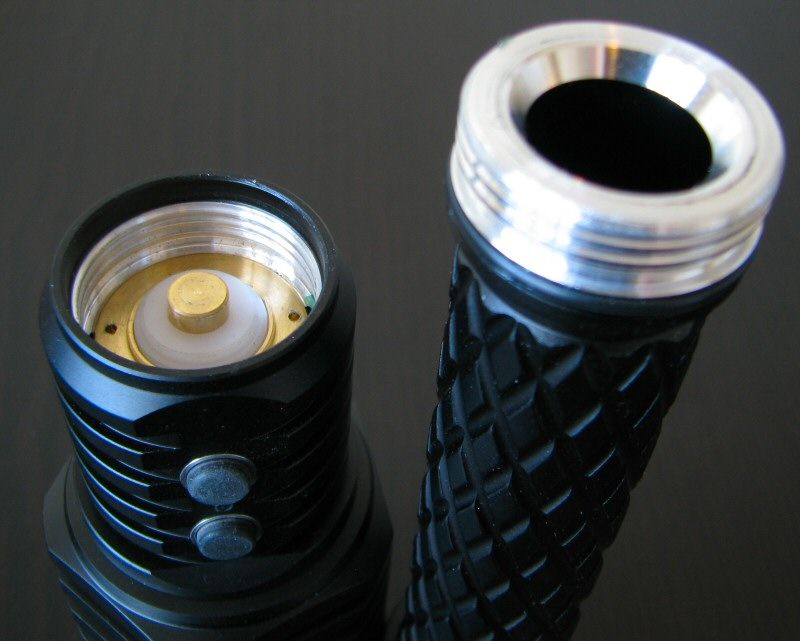
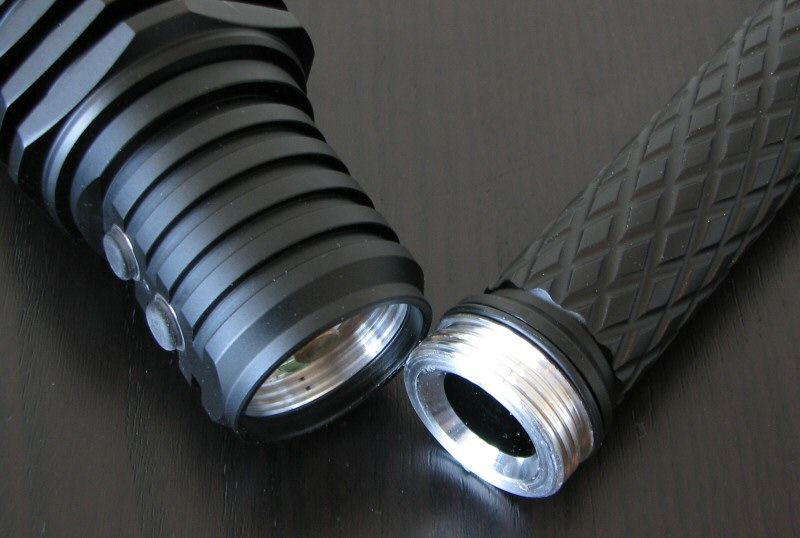
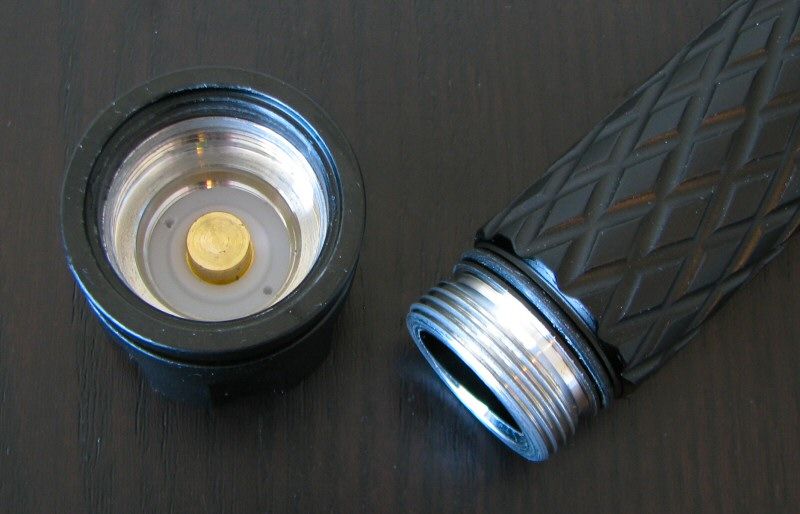
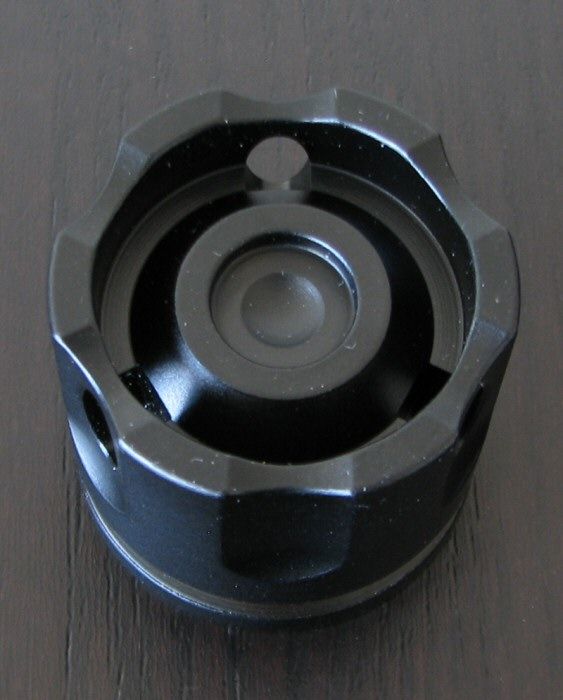
As before, the Thrunite Catapult V5 is one beefy light. oo: This line has always had a very thick-walled build, with high weight for the class. Anodizing is as before, a glossy black with no chips or damage on my sample. Labels were sharp and bright white against the black background. There isn't traditional knurling per se, but the V5 uses the same checkered pattern on the battery handle for grip. Thanks to the relative sharp edges, grip is very good on the Catapult series.
oo: This line has always had a very thick-walled build, with high weight for the class. Anodizing is as before, a glossy black with no chips or damage on my sample. Labels were sharp and bright white against the black background. There isn't traditional knurling per se, but the V5 uses the same checkered pattern on the battery handle for grip. Thanks to the relative sharp edges, grip is very good on the Catapult series.
The main change from the V3 build is the use of two electronic switches in the head now, instead of the tailcap clicky/head twist control mechanism. See my User Interface for a discussion of how they work. Switch feel has a little more resistance here than typical I find, and the switches themselves are fairly small. There is a definite click sound on a full press.
The body handle is one solid piece now – it no longer separates to allow 1x18650 use. There are cosmetic touches to the styling at the base of the head and tailcap, and bezel is more polished now (but still made of stainless steel).
Another difference is screw thread diameter has changed at the head (unchanged at the tailcap). Threads are also no longer anodized for lock-out. Threads are standard triangular cut in the tail, and square-cut in the head. All seem of good quality.
There are spring in the head and tailcap, both covered by a brass-colored cap. The tailcap has a redesigned appearance, and the light can tailstand as before (the raised ridges also serve as attachment points for the wrist lanyard).
Here's an interesting addition to stock package – Thrunite has thrown in their flip-top diffuser:

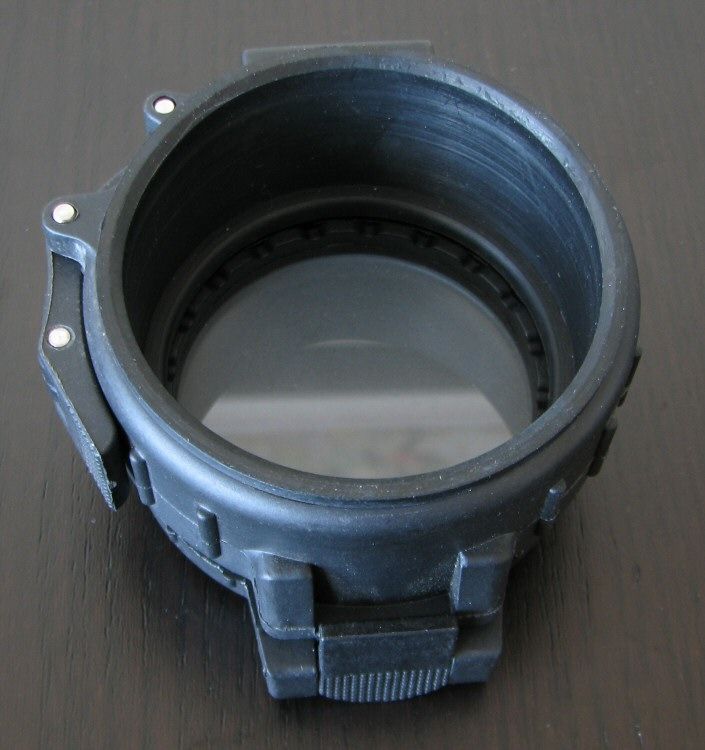
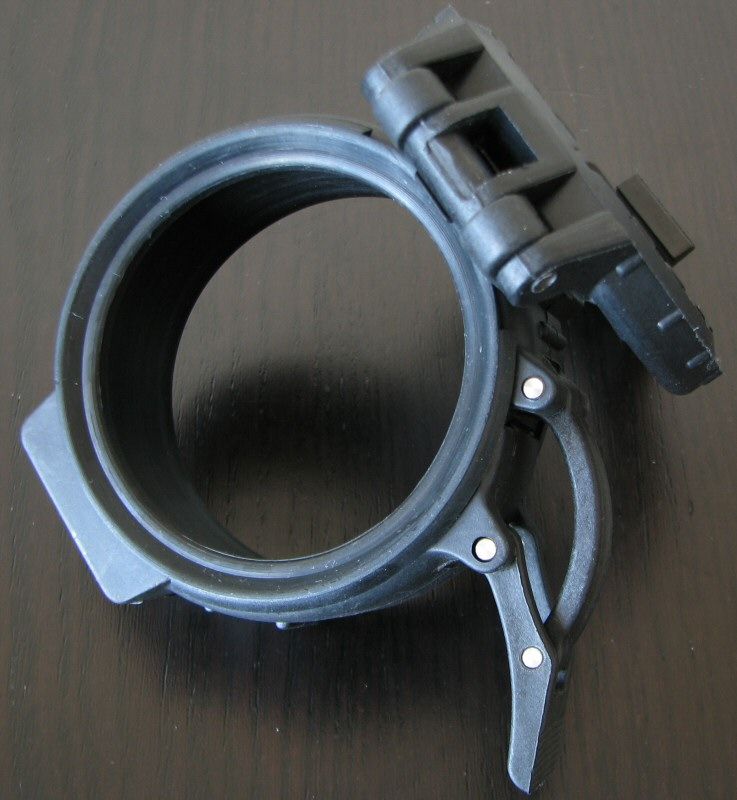


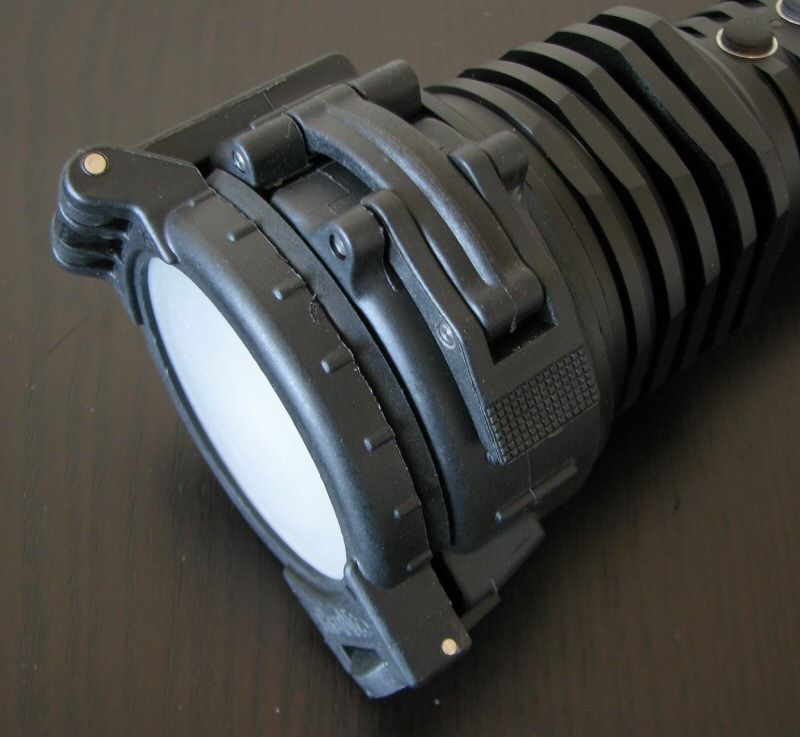
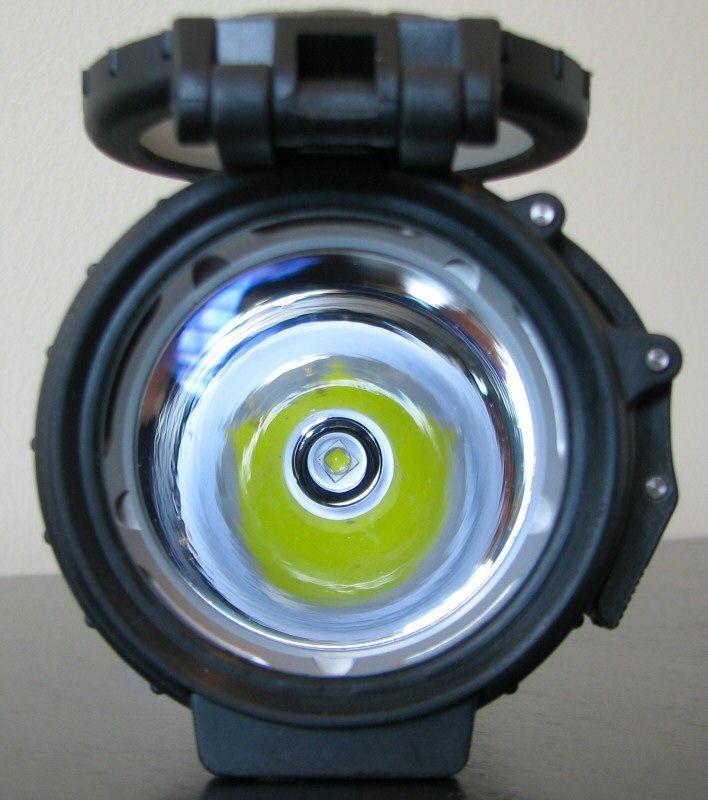
The Thrunite snap-on, flip-top diffuser is very similar to the old Surefire Beam Shapers (e.g., see my old UB3T review). You loosen the side clamp and slide the diffuser assembly over the bezel. Once in position, clamp down to hold the diffuser on securely. There is a spring-mounted latch that holds the diffuser cover down. Presumably, you could swap out the diffuser lens with colored filters, if available.
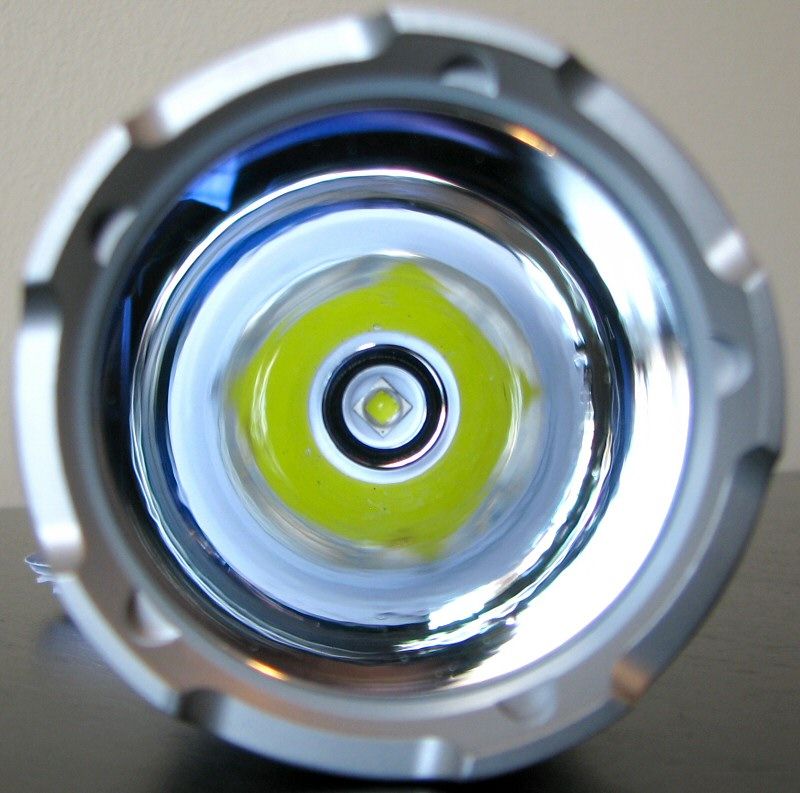

The XM-L2 emitter was well-centered at the base of a very large and deep reflector on my Cat V5. Overall reflector dimensions look similar to V3, but I haven't measured it. Smooth finish as before, this should provide outstanding throw. There is a good quality anti-glare coating on the lens. Scroll down for beamshots. :wave:
User Interface
Turn the light off/on by clicking the lower electronic switch.
Change output modes by clicking the upper electronic switch. Mode sequence is Lo > Med > Hi > Turbo, in repeating sequence. There is mode memory, and the light will return the last level used after turning off/on.
To access Strobe while on, press and hold the upper mode switch. To access Strobe directly from off, similarly press and hold the upper mode switch (momentary mode). If you hold the switch down for more than 3 seconds, the light will remain in constant Strobe mode once you release.
To lock out the light, hold down the lower electronic switch for between 3-6 seconds. After 3 secs, the main beam will flash twice. Once you release the switch after this point, the light will be locked out. Hold the switch down for 6 secs to unlock.
There is small, faint LED indicator indicator located between to two switches. This flashes blue once ever ~12 secs or so when in standby (i.e., off, with battery installed). It turns on in constant blue when the light is running. It turns red as the batteries are running low, and starts flashing red once they are nearly exhausted.
Video:
For more information on the overall build and user interface of the final shipping BK-FA-series, please see my video overview:
Videos were recorded in 720p, but YouTube typically defaults to 360p. Once the video is running, you can click on the configuration settings icon and select the higher 480p to 720p options. You can also run full-screen.
As with all my videos, I recommend you have annotations turned on. I commonly update the commentary with additional information or clarifications before publicly releasing the video.
PWM/Strobe
There is no sign of PWM on any level – I believe the light is current-controlled.
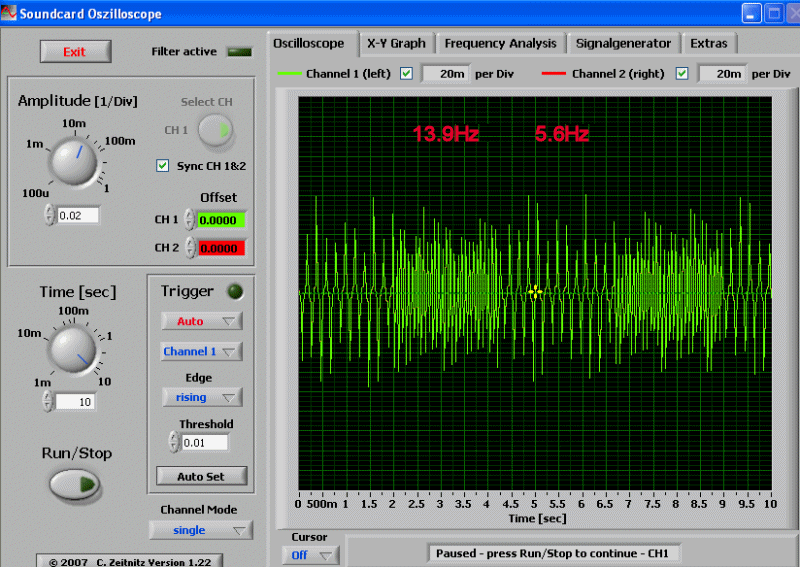
As with other recent Thrunite lights, strobe is an oscillating frequency strobe, switching between 5.6Hz and 13.9Hz on my sample. Each frequency lasts for about ~2 secs. Here is a blow-up of each strobe frequency individually:
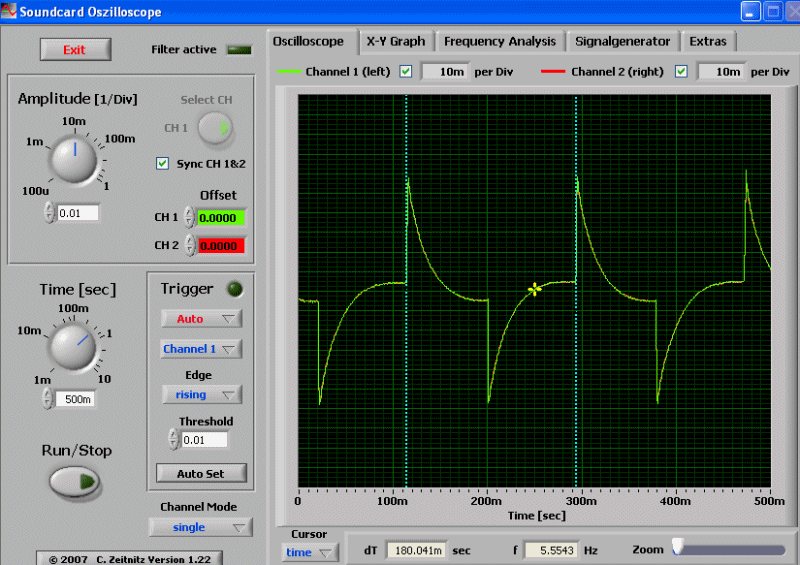
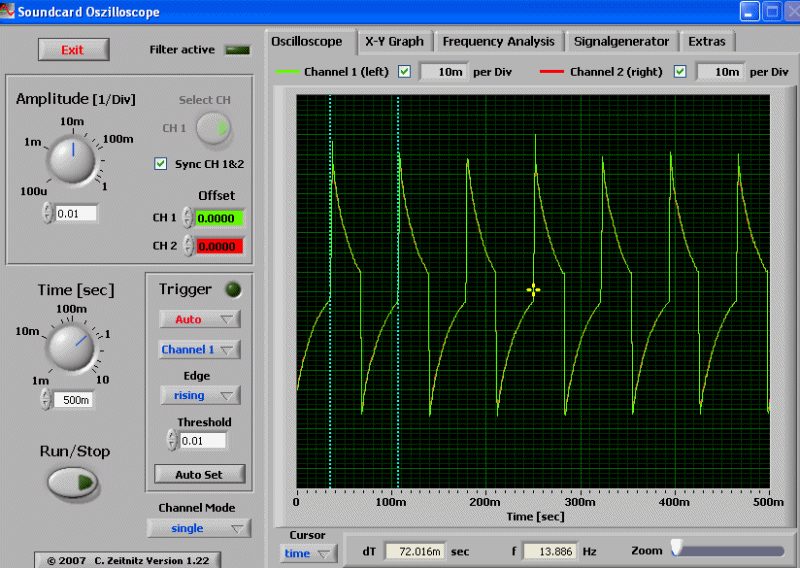
There is a bit of a ramp-up to the peak strobe output, but it is not something you could see in practice. Strobe is quite blazingly fast to the eye.
Standby Drain
Due to the electronic switch control in the head, the Cat V5 will be drawing a small current when batteries are installed. I have measured this current as 34uA on first connection, 9uA after the first few seconds. There is a quick flash of the blue LED indicator every 12 secs or, but I am not able to get a good reading during that time. If we say the average current is ~10uA over time, that would translate into 35 years before 3100mAh cells would be drained. As this is below the self-discharge rate of Li-ions, you have nothing to worry about.
Unfortunately, you cannot lock out the switch physically (i.e., screw threads are not anodized). To prevent accidental activation, you can lock out the switch by pressing and holding for 6 secs (repeat to unlock).
Beamshots:
And now, what you have all been waiting for. All lights are on 2x AW protected 18650 2200mAh. Lights are about ~0.75 meter from a white wall (with the camera ~1.25 meters back from the wall). Automatic white balance on the camera, to minimize tint differences.
All lights are on 2x AW protected 18650 2200mAh. Lights are about ~0.75 meter from a white wall (with the camera ~1.25 meters back from the wall). Automatic white balance on the camera, to minimize tint differences.
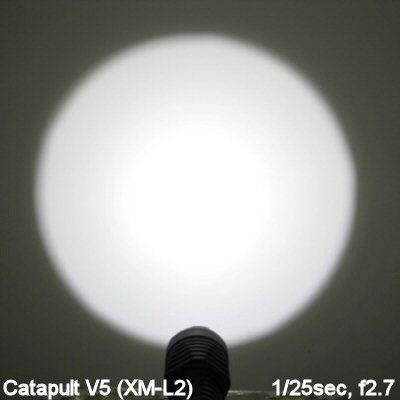
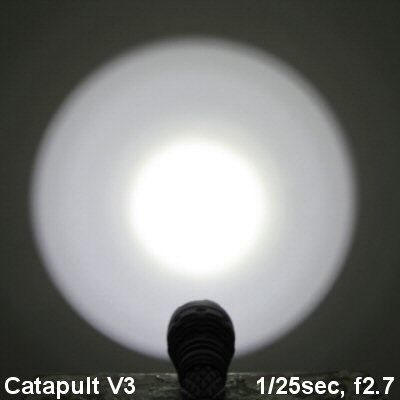
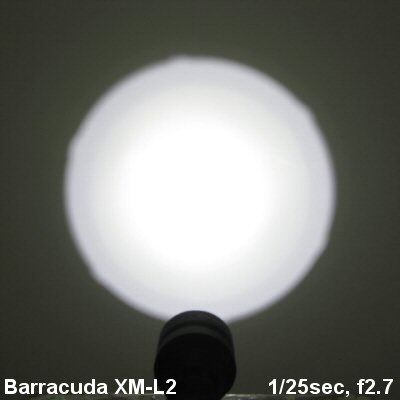
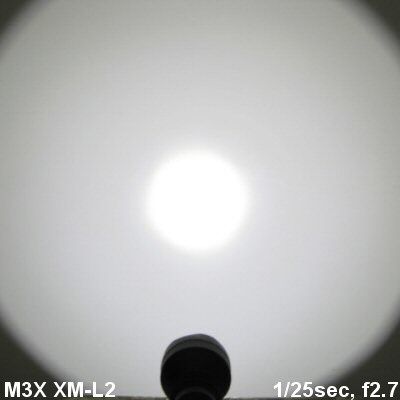
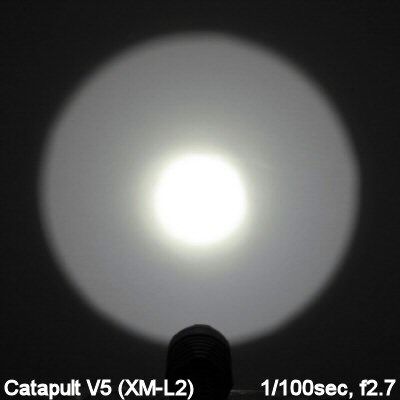
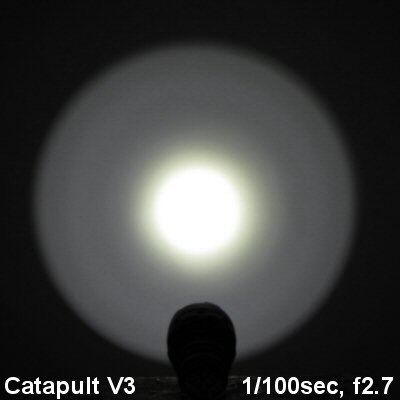
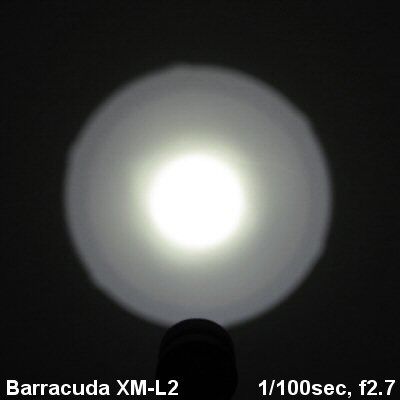
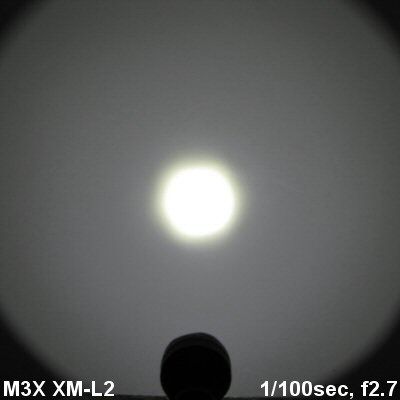
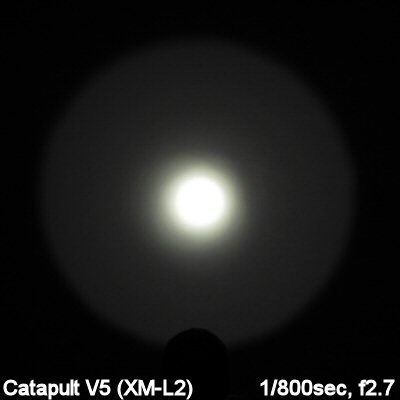
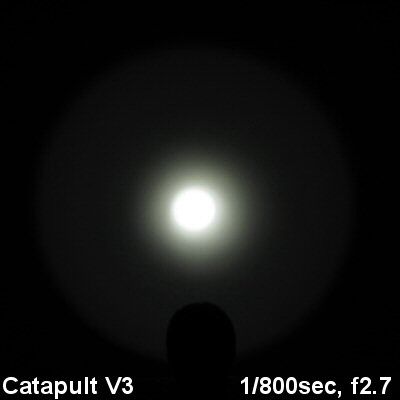
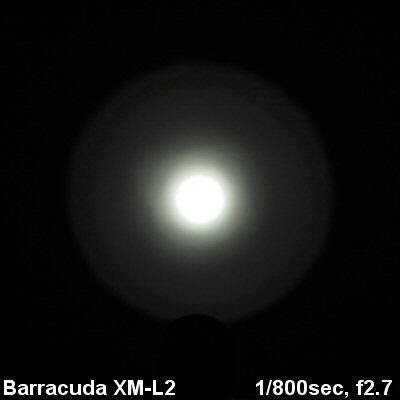
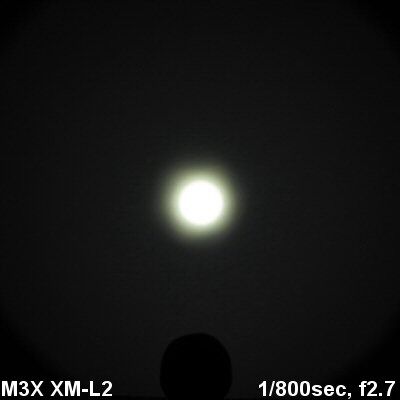
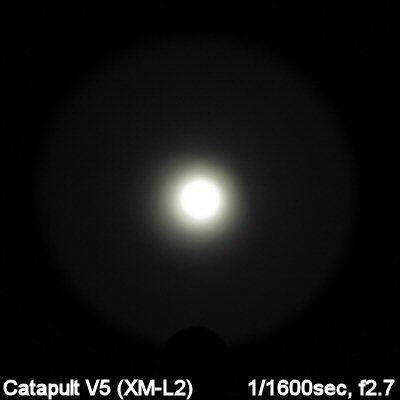
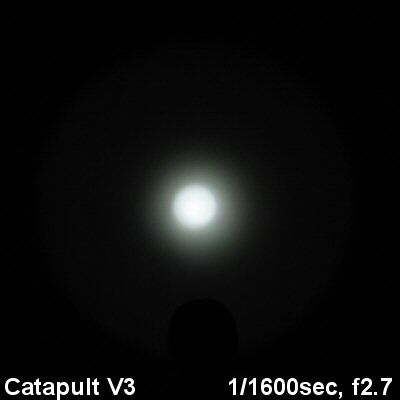
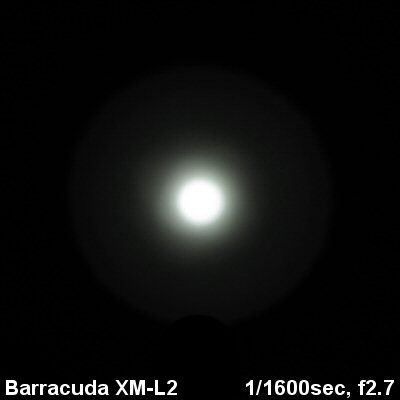
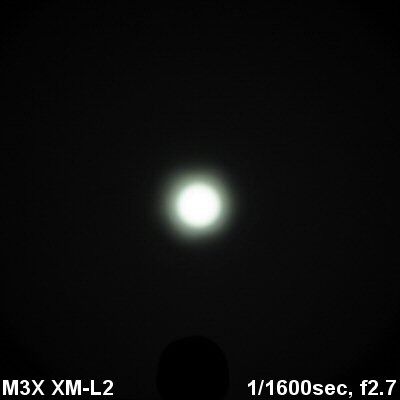
Obviously, it's hard to tell much at such ridiculously close distances. The most obvious observation is that the Catapult V5 has a very similar beam profile to the V3 - but with a lot more output (and throw).
It is interesting to compare to the two other top XM-L2 throwers in the 2x18650 class - the ArmyTek Barracuda and Olight M3X. The Barracuda has a deeper and narrower reflector, giving you good throw, but at the expense of spillbeam width (compared to most other lights). The M3X has a relatively wide reflector, giving you a much wider spillbeam width than the Catapults.
Unfortunately, spring is still slow in showing up in my part of Canada. Outdoor shots still aren't feasible for at least a few more weeks – I will update this thread once they are ready.
For now, you will have to make do with some indoor shots in my basement. For your reference, the back of the couch is about 7 feet away (~2.3m) from the opening of the light, and the far wall is about 18 feet away (~5.9m). Below I am showing a couple of exposures, to allow you to better compare hotspot and spill.
Let's compare the Catapult V5 to the earlier V3, and the ArmyTek Barracuda:
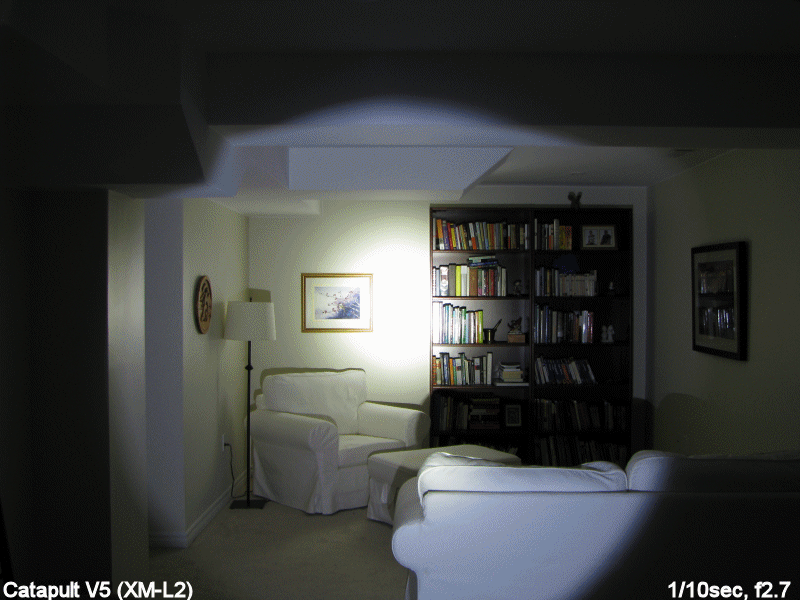
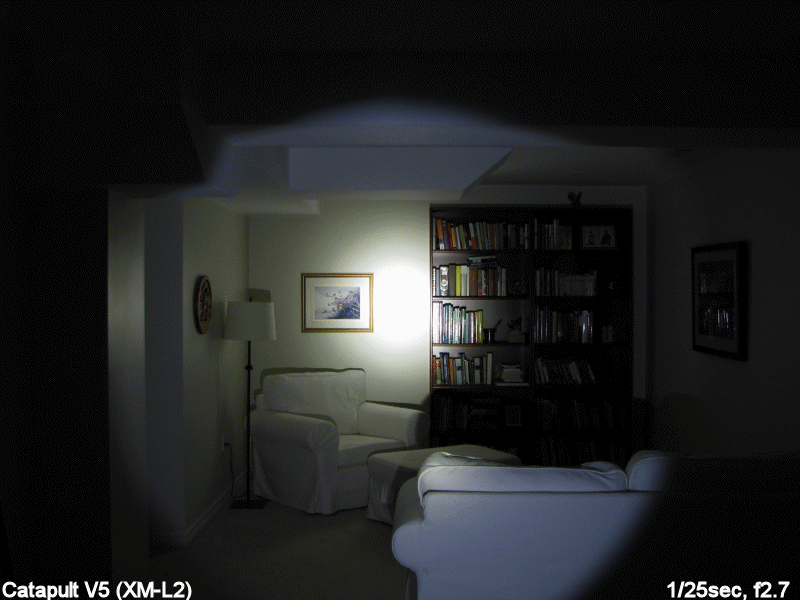
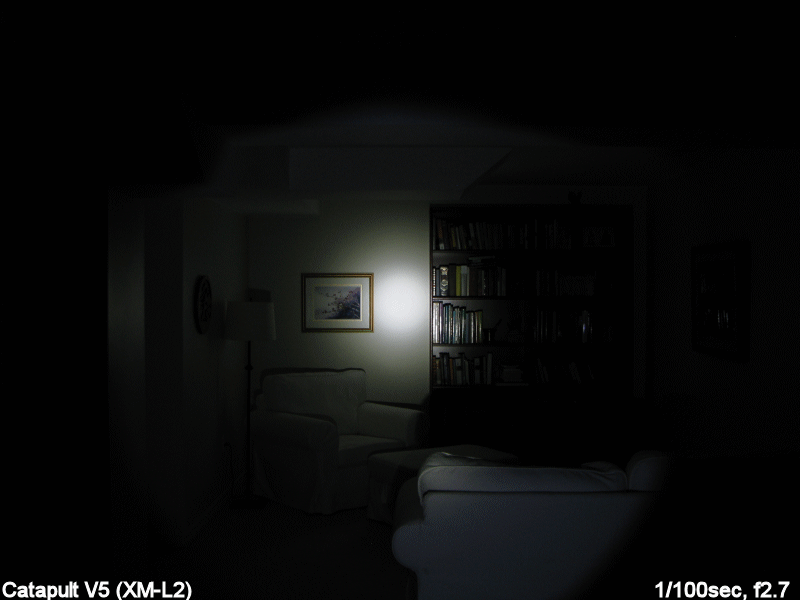
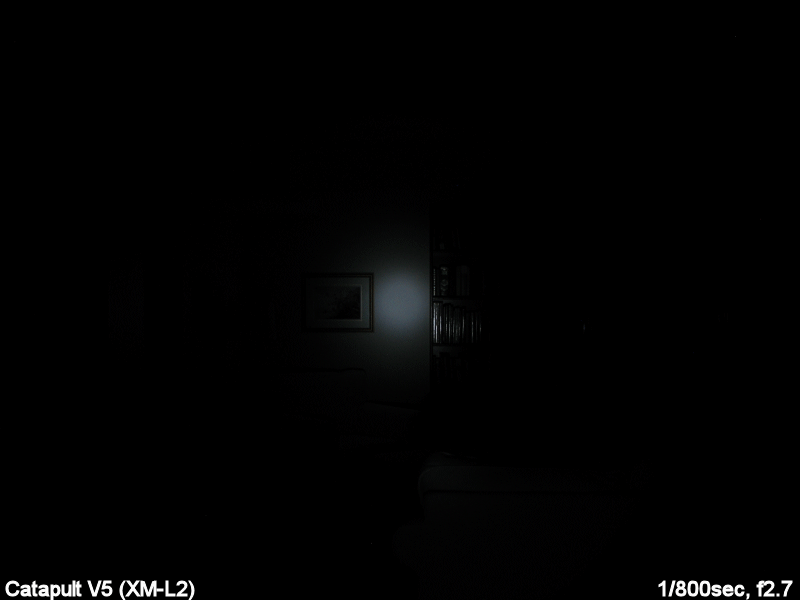
I've done a lot of exposures above so that you can directly compare. Technically, the Barracuda can produce about the same peak intensity throw (i.e., compare the center of the hotspots). But it should be obvious from the above that the Catapult V5 has a more uniformly bright hotspot. The result is that everything that falls into that Cat V5 hotpot is evenly lit, whereas the Barracuda has a gradation in output from the center to the edge.
UPDATE May 17, 2014: Weather conditions have finally improved enough to start taking outdoor beamshots around here. Here is a comparison of the Catapult V5 to the Thrunite TN32, and Fenix TK61 (stock).
As always, these are done in the style of my earlier 100-yard round-up review. Please see that thread for a discussion of the topography (i.e. the road dips in the distance, to better show you the corona in the mid-ground).
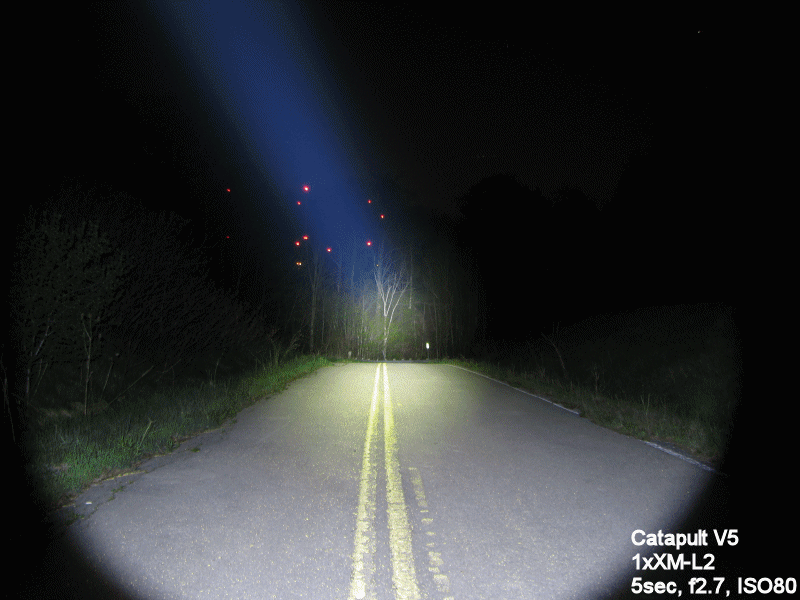

I realize these comparisons are a little unfair, as the Catapult V5 is only a 2x18650 light (compared to 3x and 4x specimens above). But it goes to show you how impressive the V5 is, that it can approach the larger and more heavily-driven TN32. oo: If I get the chance to compare the V5 to other lights in the 2x18650 class, I will update this review. :wave:
oo: If I get the chance to compare the V5 to other lights in the 2x18650 class, I will update this review. :wave:
UPDATE JUNE 12, 2014: FYI, here is an additional outdoor beamshot with and without the diffuser in place.
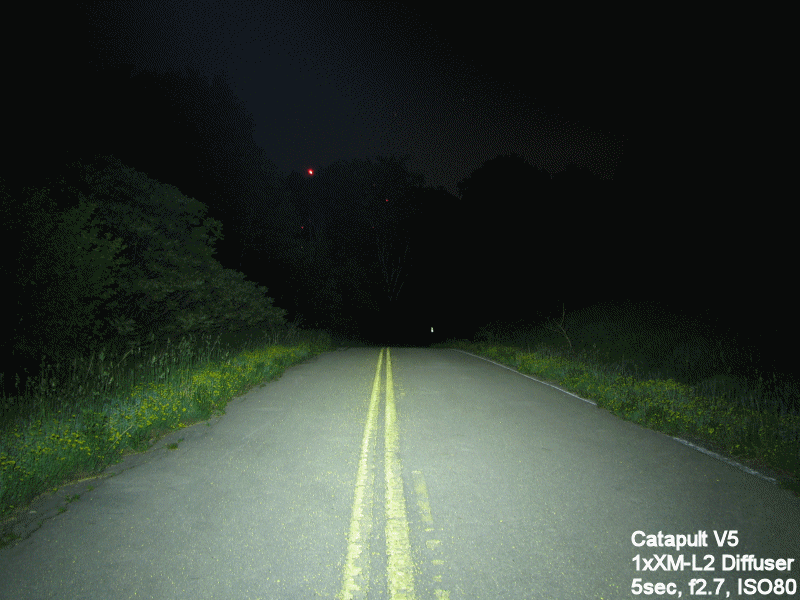
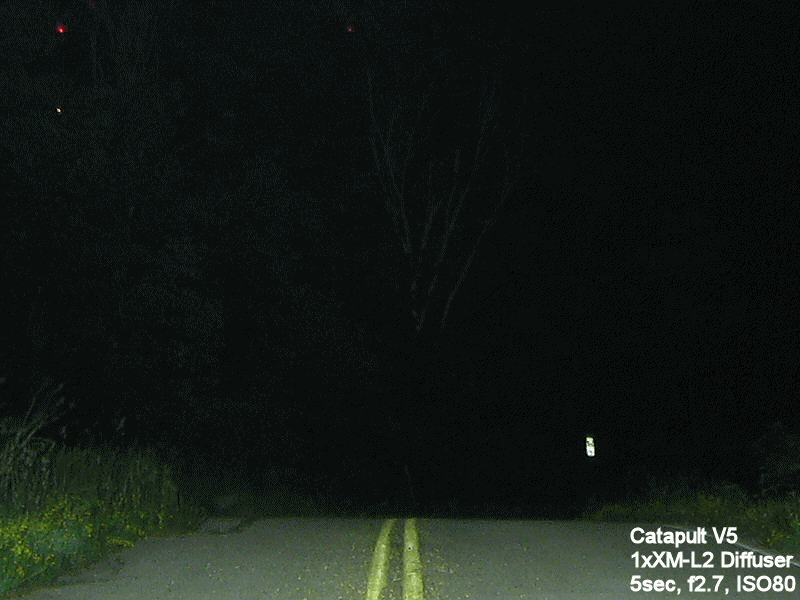
Testing Method:
All my output numbers are relative for my home-made light box setup, as described on my flashlightreviews.ca website. You can directly compare all my relative output values from different reviews - i.e. an output value of "10" in one graph is the same as "10" in another. All runtimes are done under a cooling fan, except for any extended run Lo/Min modes (i.e. >12 hours) which are done without cooling.
I have devised a method for converting my lightbox relative output values (ROV) to estimated Lumens. See my How to convert Selfbuilt's Lightbox values to Lumens thread for more info.
Throw/Output Summary Chart:
My summary tables are reported in a manner consistent with the ANSI FL-1 standard for flashlight testing. Please see http://www.flashlightreviews.ca/FL1.htm for a discussion, and a description of all the terms used in these tables. Effective July 2012, I have updated all my Peak Intensity/Beam Distance measures with a NIST-certified Extech EA31 lightmeter (orange highlights).

As you could probably tell from the indoor beamshots, the Cat V5 is a lot brighter than the Cat V3 – both for output and for throw. In terms of peak intensity center beam, the Cat V5 narrowly squeezes past the ArmyTek Barracuda (which is not driven as hard overall). Given the significant differences in the beam pattern of all the max thrower lights, the beamshots really tell this story the best – scroll back up for some shots.
I put the TN32 down for comparison, as the Cat V5 is nearing that level of output (although only on 2x18650). As you can tell from above though, the much larger reflector on the TN32 gives this light a considerable throw advantage.
As an aside, it's nice to see that the ANSI FL-1 specs for output and center beam intensity are bang-on with my sample.
Here is a breakdown of the estimated lumen values for both the Cat V3 and V5 in my testing:
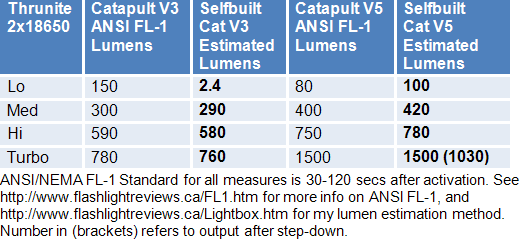
As usual, Thrunite's output specs remain remarkably consistent with my testing – making me thing they did indeed get these tested in a properly-calibrated integrating sphere. The exception above is the Lo level of the Cat V3, but that may have been due to the early review sample I received (i.e., later models were adjusted for Lo).
There is a thermal-controlled step-down on the Cat V5. However, the reduced output step is actually very similar to the max output of other 2x18650 thrower lights I've tested. oo: See my runtimes below for more info.
oo: See my runtimes below for more info.
Output/Runtime Graphs:
As usual, AW protected 2200mAh cells are used in all my runtime testing
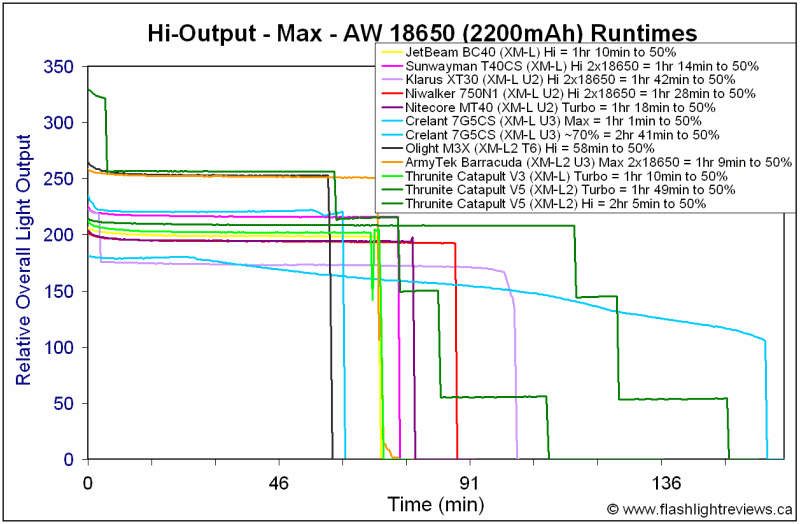
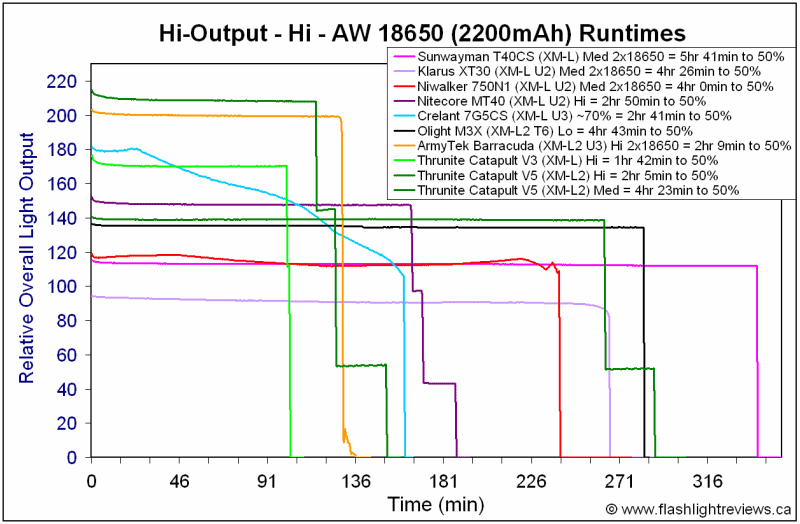
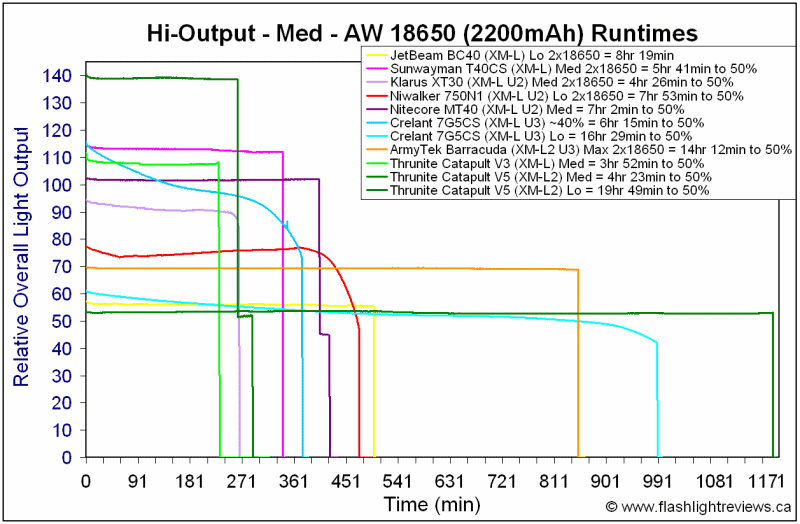
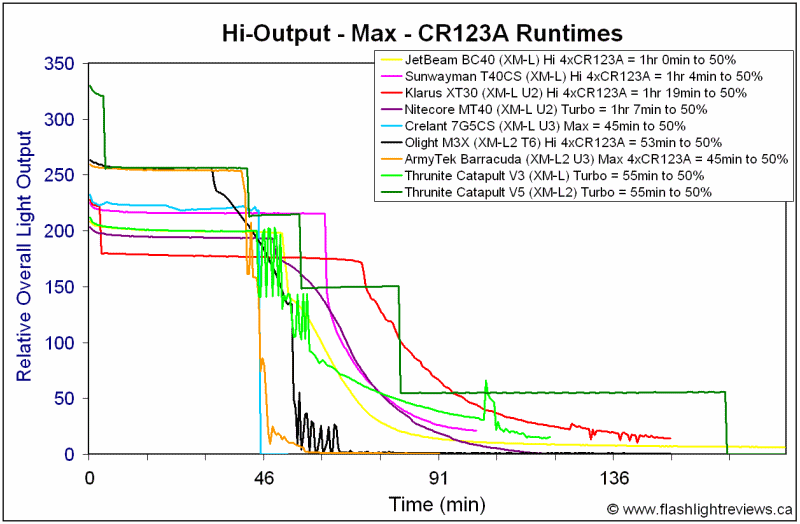
The Catapult V5 now shows a clear step-down pattern over time, as the cells drain. The first step-down from Turbo happened around 4 mins in my testing. This is actually a positive development – the earlier Catapults were heavily driven on max, without a timed or thermal step-down. This made it potentially unsafe to run on 4xCR123A (i.e., the cells internal PTC protection feature could be set off on sustained runs).
The overall output/runtime efficiency is excellent, at all levels tested. Similarly, the light shows flat stabilization at all levels (with defined step downs over time).
Any way you look at it - from an output, efficiency, or regulation perspective - the new Catapult V5 is well suited to both 2x18650 and 4xCR123A. A definite winner in my books. :thumbsup:
Potential Issues
As before, there is no true "lo" mode to speak of in the Catapult series.
The physical clicky switch has been replaced by two electronic switches in the head. As a result, there is stand-by current now when off – but it was so low (~10 uA in my testing), that it is absolutely not a concern for draining your cells. This is below the self-discharge level of Li-ion. Accidental activation is another possibility, as the light no longer has anodized threads for physical lockout - but Thrunite does provide an electronic switch lock-out feature.
Switch buttons are relatively small, and require a firmer than typical press to activate. I sometimes found nothing would happen upon a button press, if I didn't press it firmly in the center.
The bezel has a more polished/brushed appearance now, but it is still made of stainless steel.
Preliminary Observations
The Catapult V3 was a mainstay in the 2x18650 "thrower" class light for quite some time. The new V5 has a significant leap in output and corresponding throw – it's about twice as bright on max now. oo:
oo:
In addition to the raw horsepower output increase, the interface has been completely revised as well. Gone is the combination of head twist and physical clicky switch, replaced by two electronic switches in the head (one for on/off, one for mode changing). I think most people will find this interface quite intuitive. It also has a potentially nifty "hidden" feature for some – you now have instant access to strobe from Off, as either momentary or locked on.
Build-wise, the main changes are the replacement tailcap (lacking a physical switch), and the extension of the "neck" area where the electronic switches are now located. I find the switches to be a bit on the small side, requiring firmer pressure than typical for a definite click. Note as well that a physical lock-out of the light is no longer possible (i.e., screw threads are not anodized now), but there is an electronic lock-out and the standby current is so small as be below the self-discharge limit of Li-ions (i.e., not a concern for draining your light). :thumbsup: As an aside, the tailcap threads haven't changed, so you could still install the anodized tailcap (with clicky switch) from the V3 onto the V5.
For those who like a solid club-style light, rest assured that the V5 is as "beefy" a light as ever. In fact it is even longer and heavier now.
In fact it is even longer and heavier now.
Performance-wise, I am glad to see the over-heat and circuit protection features of the light now (something that was lacking from earlier models). This means the light will step down in output as the batteries drain, or if excessive heat is detected (which can happen on primary CR123A cells especially). There is a useful standby/low voltage indicator LED located between the two switches. From the specs, it would seem that unprotected cells could be safely used (but I have not tested this). Regulation and overall output/runtime efficiency were excellent on my sample, in keeping with other current-controlled lights.
Of course, what probably matters to many of you – peak beam intensity has more than doubled from my Cat V3. This nudges the Armytek Barracuda out of the top spot in my 2x18650 summary tables. In real life, I find the Cat V5 hotspot to be broader and more uniform that the Barracuda, but you will have to wait a little longer for outdoor shots (spring is coming).
Some small touches that I quite like – it is good that a holster is now included, as well as an excellent quality flip-top beam diffuser. The bundled diffuser cover is very similar to the classic Surefire beam shaper accessory (see my old UB3T review for an example). I understand a remote momentary switch is also available, and presumably a 3x18650 battery tube extender as well (since it is mentioned in the specs).
The Cat V3 was a very popular 2x18650 thrower light, and I suspect the V5 will follow down that same path given its outstanding output and throw. While some may miss the physical tailcap clicky switch, I can see the placement of the electronic switches near the head working well for how most people carry and use the light. Certainly a very impressive output/throw showing in this class, made possible by the broader range of heat and voltage protection features in the circuit. :wave:
----
Catapult V5 provided by Thrunite for review.


Thrunite has sent me the updated version their classic "thrower" light, the Catapult (now in version 5). Featuring a XM-L2, the Cat V5 runs on 2x18650 or 4xCR123A (although I understand 3x18650 is also possible with optional extender).
Does the V5 version allow Thrunite to reclaim the "throw king" crown in this class? Let us see …
Manufacturer Reported Specifications:
(note: as always, these are simply what the manufacturer provides – scroll down to see my actual testing results).
- LED: Cree XM-L2 U2 LED
- Max output: 1500 lumen; uses 2/3 18650 rechargeable batteries or 4 CR123A batteries;
- Tested by 2×18650 (2600mAh): Remote Switch Momentary On. 1000lumen (75min); 1500lumen (70min),750lumen (140min), 400lumen (305min), 80lumen (1344min);
- Working voltage: 5V-14V;
- Max beam distance: 649 meters
- Peak beam intensity: 105,400cd
- Short-circuit protection, Open circuit protection, Over-voltage protection, Under-voltage protection, Over-heat protection
- Impact resistant: 1.5M.
- Waterproof to IPX-8 standard, 2M.
- Improved UI for more lumens;
- Dimensions: 267.5mm(length) × 59.0mm(bezel diameter)
- Weight: 650g (without batteries)
- Reverse polarity protection design to protect from improper battery installation;
- Aircraft-grade aluminum body;
- Premium Type III hard-anodized anti-abrasive finish;
- Toughened ultra-clear glass lens with anti-reflective coating;
- Smooth reflector gives perfect beam and throw;
- Accessories (included): Holster, Lanyard, User's manual, diffuser, O-ring.
- MSRP: $150

Packaging is a hard cardboard box with cut-out foam. Inside are the light (in bubble wrap), open-ended belt pouch, wrist lanyard, manual, extra o-rings, and snap-on flip-top diffuser cover.



From left to right: AW Protected 18650 2200mAh; Thrunite Catapult V5, V3; Armytek Barracuda; Olight M3X; Crelant 7G5MT.
All dimensions directly measured, and given with no batteries installed (unless indicated):
Thrunite Catapult V5: Weight: 556.7g, Length: 266mm, Width (bezel) 59.1mm
Thrunite Catapult V3: Weight: 434.8g, Length: 254mm, Width (bezel) 58.0mm
ArmyTek Barracuda: Weight 400.8g, Length 264mm, Width (bezel): 64.0mm
Crelant 7G5CS: Weight: 334.5g, Length: 247mm Width (bezel): 64.0mm
Eagletac GX25L2 Turbo: Weight: 320.7g (with battery pack: 412.5g), Length: 251mm, Width (bezel): 62.0mm
Eagletac SX25L2 Turbo: Weight: 343.4g (with battery pack: 534.3g), Length: 255mm, Width (bezel): 62.0mm
Klarus XT30: Weight: 283.1g, Length: 247mm, Width (bezel): 58.0mm
Niwalker 750N1: Weight: 408.0g, Length: 269mm, Width (bezel): 58.6mm
Olight M3X with Extender: Weight 277.8g, Length 244mm, Width (bezel): 62.3mm
Sunwayman T40CS: Weight: 296.7g, Length 227, Width (bezel): 63.5mm
Surefire UB3T: Weight: 311.1g, Length 229mm, Width (bezel): 63.1 mm






As before, the Thrunite Catapult V5 is one beefy light.
The main change from the V3 build is the use of two electronic switches in the head now, instead of the tailcap clicky/head twist control mechanism. See my User Interface for a discussion of how they work. Switch feel has a little more resistance here than typical I find, and the switches themselves are fairly small. There is a definite click sound on a full press.
The body handle is one solid piece now – it no longer separates to allow 1x18650 use. There are cosmetic touches to the styling at the base of the head and tailcap, and bezel is more polished now (but still made of stainless steel).
Another difference is screw thread diameter has changed at the head (unchanged at the tailcap). Threads are also no longer anodized for lock-out. Threads are standard triangular cut in the tail, and square-cut in the head. All seem of good quality.
There are spring in the head and tailcap, both covered by a brass-colored cap. The tailcap has a redesigned appearance, and the light can tailstand as before (the raised ridges also serve as attachment points for the wrist lanyard).
Here's an interesting addition to stock package – Thrunite has thrown in their flip-top diffuser:







The Thrunite snap-on, flip-top diffuser is very similar to the old Surefire Beam Shapers (e.g., see my old UB3T review). You loosen the side clamp and slide the diffuser assembly over the bezel. Once in position, clamp down to hold the diffuser on securely. There is a spring-mounted latch that holds the diffuser cover down. Presumably, you could swap out the diffuser lens with colored filters, if available.


The XM-L2 emitter was well-centered at the base of a very large and deep reflector on my Cat V5. Overall reflector dimensions look similar to V3, but I haven't measured it. Smooth finish as before, this should provide outstanding throw. There is a good quality anti-glare coating on the lens. Scroll down for beamshots. :wave:
User Interface
Turn the light off/on by clicking the lower electronic switch.
Change output modes by clicking the upper electronic switch. Mode sequence is Lo > Med > Hi > Turbo, in repeating sequence. There is mode memory, and the light will return the last level used after turning off/on.
To access Strobe while on, press and hold the upper mode switch. To access Strobe directly from off, similarly press and hold the upper mode switch (momentary mode). If you hold the switch down for more than 3 seconds, the light will remain in constant Strobe mode once you release.
To lock out the light, hold down the lower electronic switch for between 3-6 seconds. After 3 secs, the main beam will flash twice. Once you release the switch after this point, the light will be locked out. Hold the switch down for 6 secs to unlock.
There is small, faint LED indicator indicator located between to two switches. This flashes blue once ever ~12 secs or so when in standby (i.e., off, with battery installed). It turns on in constant blue when the light is running. It turns red as the batteries are running low, and starts flashing red once they are nearly exhausted.
Video:
For more information on the overall build and user interface of the final shipping BK-FA-series, please see my video overview:
Videos were recorded in 720p, but YouTube typically defaults to 360p. Once the video is running, you can click on the configuration settings icon and select the higher 480p to 720p options. You can also run full-screen.
As with all my videos, I recommend you have annotations turned on. I commonly update the commentary with additional information or clarifications before publicly releasing the video.
PWM/Strobe
There is no sign of PWM on any level – I believe the light is current-controlled.

As with other recent Thrunite lights, strobe is an oscillating frequency strobe, switching between 5.6Hz and 13.9Hz on my sample. Each frequency lasts for about ~2 secs. Here is a blow-up of each strobe frequency individually:


There is a bit of a ramp-up to the peak strobe output, but it is not something you could see in practice. Strobe is quite blazingly fast to the eye.
Standby Drain
Due to the electronic switch control in the head, the Cat V5 will be drawing a small current when batteries are installed. I have measured this current as 34uA on first connection, 9uA after the first few seconds. There is a quick flash of the blue LED indicator every 12 secs or, but I am not able to get a good reading during that time. If we say the average current is ~10uA over time, that would translate into 35 years before 3100mAh cells would be drained. As this is below the self-discharge rate of Li-ions, you have nothing to worry about.
Unfortunately, you cannot lock out the switch physically (i.e., screw threads are not anodized). To prevent accidental activation, you can lock out the switch by pressing and holding for 6 secs (repeat to unlock).
Beamshots:
And now, what you have all been waiting for.
















Obviously, it's hard to tell much at such ridiculously close distances. The most obvious observation is that the Catapult V5 has a very similar beam profile to the V3 - but with a lot more output (and throw).
It is interesting to compare to the two other top XM-L2 throwers in the 2x18650 class - the ArmyTek Barracuda and Olight M3X. The Barracuda has a deeper and narrower reflector, giving you good throw, but at the expense of spillbeam width (compared to most other lights). The M3X has a relatively wide reflector, giving you a much wider spillbeam width than the Catapults.
Unfortunately, spring is still slow in showing up in my part of Canada. Outdoor shots still aren't feasible for at least a few more weeks – I will update this thread once they are ready.
For now, you will have to make do with some indoor shots in my basement. For your reference, the back of the couch is about 7 feet away (~2.3m) from the opening of the light, and the far wall is about 18 feet away (~5.9m). Below I am showing a couple of exposures, to allow you to better compare hotspot and spill.
Let's compare the Catapult V5 to the earlier V3, and the ArmyTek Barracuda:




I've done a lot of exposures above so that you can directly compare. Technically, the Barracuda can produce about the same peak intensity throw (i.e., compare the center of the hotspots). But it should be obvious from the above that the Catapult V5 has a more uniformly bright hotspot. The result is that everything that falls into that Cat V5 hotpot is evenly lit, whereas the Barracuda has a gradation in output from the center to the edge.
UPDATE May 17, 2014: Weather conditions have finally improved enough to start taking outdoor beamshots around here. Here is a comparison of the Catapult V5 to the Thrunite TN32, and Fenix TK61 (stock).
As always, these are done in the style of my earlier 100-yard round-up review. Please see that thread for a discussion of the topography (i.e. the road dips in the distance, to better show you the corona in the mid-ground).


I realize these comparisons are a little unfair, as the Catapult V5 is only a 2x18650 light (compared to 3x and 4x specimens above). But it goes to show you how impressive the V5 is, that it can approach the larger and more heavily-driven TN32.
UPDATE JUNE 12, 2014: FYI, here is an additional outdoor beamshot with and without the diffuser in place.


Testing Method:
All my output numbers are relative for my home-made light box setup, as described on my flashlightreviews.ca website. You can directly compare all my relative output values from different reviews - i.e. an output value of "10" in one graph is the same as "10" in another. All runtimes are done under a cooling fan, except for any extended run Lo/Min modes (i.e. >12 hours) which are done without cooling.
I have devised a method for converting my lightbox relative output values (ROV) to estimated Lumens. See my How to convert Selfbuilt's Lightbox values to Lumens thread for more info.
Throw/Output Summary Chart:
My summary tables are reported in a manner consistent with the ANSI FL-1 standard for flashlight testing. Please see http://www.flashlightreviews.ca/FL1.htm for a discussion, and a description of all the terms used in these tables. Effective July 2012, I have updated all my Peak Intensity/Beam Distance measures with a NIST-certified Extech EA31 lightmeter (orange highlights).

As you could probably tell from the indoor beamshots, the Cat V5 is a lot brighter than the Cat V3 – both for output and for throw. In terms of peak intensity center beam, the Cat V5 narrowly squeezes past the ArmyTek Barracuda (which is not driven as hard overall). Given the significant differences in the beam pattern of all the max thrower lights, the beamshots really tell this story the best – scroll back up for some shots.
I put the TN32 down for comparison, as the Cat V5 is nearing that level of output (although only on 2x18650). As you can tell from above though, the much larger reflector on the TN32 gives this light a considerable throw advantage.
As an aside, it's nice to see that the ANSI FL-1 specs for output and center beam intensity are bang-on with my sample.
Here is a breakdown of the estimated lumen values for both the Cat V3 and V5 in my testing:

As usual, Thrunite's output specs remain remarkably consistent with my testing – making me thing they did indeed get these tested in a properly-calibrated integrating sphere. The exception above is the Lo level of the Cat V3, but that may have been due to the early review sample I received (i.e., later models were adjusted for Lo).
There is a thermal-controlled step-down on the Cat V5. However, the reduced output step is actually very similar to the max output of other 2x18650 thrower lights I've tested.
Output/Runtime Graphs:
As usual, AW protected 2200mAh cells are used in all my runtime testing




The Catapult V5 now shows a clear step-down pattern over time, as the cells drain. The first step-down from Turbo happened around 4 mins in my testing. This is actually a positive development – the earlier Catapults were heavily driven on max, without a timed or thermal step-down. This made it potentially unsafe to run on 4xCR123A (i.e., the cells internal PTC protection feature could be set off on sustained runs).
The overall output/runtime efficiency is excellent, at all levels tested. Similarly, the light shows flat stabilization at all levels (with defined step downs over time).
Any way you look at it - from an output, efficiency, or regulation perspective - the new Catapult V5 is well suited to both 2x18650 and 4xCR123A. A definite winner in my books. :thumbsup:
Potential Issues
As before, there is no true "lo" mode to speak of in the Catapult series.
The physical clicky switch has been replaced by two electronic switches in the head. As a result, there is stand-by current now when off – but it was so low (~10 uA in my testing), that it is absolutely not a concern for draining your cells. This is below the self-discharge level of Li-ion. Accidental activation is another possibility, as the light no longer has anodized threads for physical lockout - but Thrunite does provide an electronic switch lock-out feature.
Switch buttons are relatively small, and require a firmer than typical press to activate. I sometimes found nothing would happen upon a button press, if I didn't press it firmly in the center.
The bezel has a more polished/brushed appearance now, but it is still made of stainless steel.
Preliminary Observations
The Catapult V3 was a mainstay in the 2x18650 "thrower" class light for quite some time. The new V5 has a significant leap in output and corresponding throw – it's about twice as bright on max now.
In addition to the raw horsepower output increase, the interface has been completely revised as well. Gone is the combination of head twist and physical clicky switch, replaced by two electronic switches in the head (one for on/off, one for mode changing). I think most people will find this interface quite intuitive. It also has a potentially nifty "hidden" feature for some – you now have instant access to strobe from Off, as either momentary or locked on.
Build-wise, the main changes are the replacement tailcap (lacking a physical switch), and the extension of the "neck" area where the electronic switches are now located. I find the switches to be a bit on the small side, requiring firmer pressure than typical for a definite click. Note as well that a physical lock-out of the light is no longer possible (i.e., screw threads are not anodized now), but there is an electronic lock-out and the standby current is so small as be below the self-discharge limit of Li-ions (i.e., not a concern for draining your light). :thumbsup: As an aside, the tailcap threads haven't changed, so you could still install the anodized tailcap (with clicky switch) from the V3 onto the V5.
For those who like a solid club-style light, rest assured that the V5 is as "beefy" a light as ever.
Performance-wise, I am glad to see the over-heat and circuit protection features of the light now (something that was lacking from earlier models). This means the light will step down in output as the batteries drain, or if excessive heat is detected (which can happen on primary CR123A cells especially). There is a useful standby/low voltage indicator LED located between the two switches. From the specs, it would seem that unprotected cells could be safely used (but I have not tested this). Regulation and overall output/runtime efficiency were excellent on my sample, in keeping with other current-controlled lights.
Of course, what probably matters to many of you – peak beam intensity has more than doubled from my Cat V3. This nudges the Armytek Barracuda out of the top spot in my 2x18650 summary tables. In real life, I find the Cat V5 hotspot to be broader and more uniform that the Barracuda, but you will have to wait a little longer for outdoor shots (spring is coming).
Some small touches that I quite like – it is good that a holster is now included, as well as an excellent quality flip-top beam diffuser. The bundled diffuser cover is very similar to the classic Surefire beam shaper accessory (see my old UB3T review for an example). I understand a remote momentary switch is also available, and presumably a 3x18650 battery tube extender as well (since it is mentioned in the specs).
The Cat V3 was a very popular 2x18650 thrower light, and I suspect the V5 will follow down that same path given its outstanding output and throw. While some may miss the physical tailcap clicky switch, I can see the placement of the electronic switches near the head working well for how most people carry and use the light. Certainly a very impressive output/throw showing in this class, made possible by the broader range of heat and voltage protection features in the circuit. :wave:
----
Catapult V5 provided by Thrunite for review.
Last edited:


